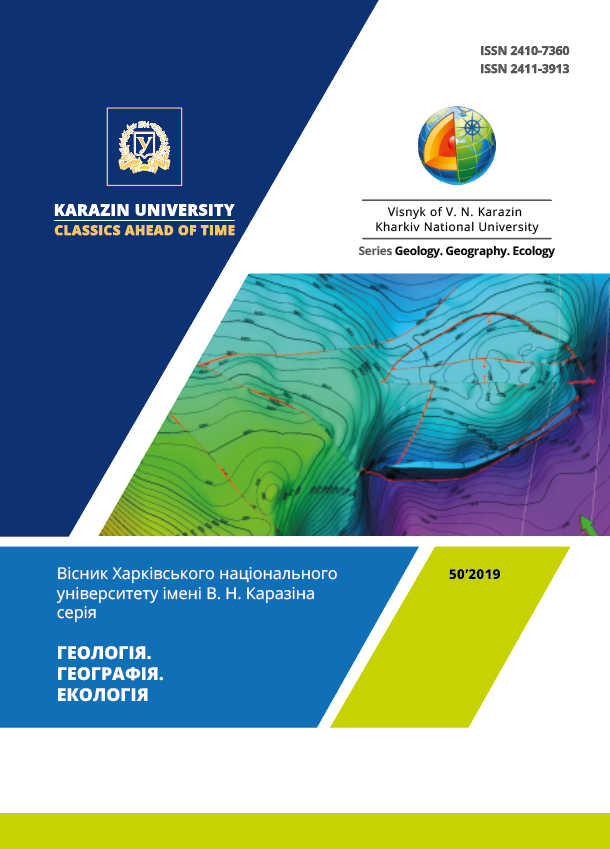Математичне моделювання акустичної і пружної анізотропії сланцевих порід-колекторів Дніпровсько-Донецької западини
Анотація
Мета роботи – аналіз параметрів пружної і акустичної анізотропії при дослідженні багатокомпонентної моделі породи-колектора, яка представлена сланцем. Для вирішення поставленого завдання використовувалися методи умовних моментних функцій з використанням розрахункової схеми Морі-Танака, а також метод найменших квадратів. Розроблено методику математичного моделювання ефективних пружних постійних нетрадиційних сланцевих порід-колекторів.
Обґрунтовано і розроблено 8 різновидів математичних моделей, що характеризують мінеральний склад, структуру пустотного простору і пружні властивості, які характерні для сланцевих порід-колекторів Дніпровсько-Донецької западини України. В основу моделей взяті попередні публікації авторів і результати петрографічних досліджень в ННІ «Інститут геології». Авторами вперше проведено аналіз пружних постійних моделей порід, компонентів акустичного тензора, параметрів лінійності і сланцеватості, стереопроєкції ізоліній вказівних поверхонь дев'яти параметрів пружної анізотропії, а також параметри Томсена. Встановлено, що за акустичними даними можливо простежити зміну структури пустотного простору породи-колектора, концентрацію породотвірних мінералів в породі. Тріщинуватість має більший вплив на структуру породи, ніж гранулярні пустоти і структура мінералів. Найбільші значення (більше 20%) мають коефіцієнти анізотропії в породах, де пустоти орієнтовані в площині перпендикулярній осі свердловини.
При розрахунках параметрів Томсена отримані параметри пружної анізотропії, які характеризують не тільки мінеральний склад порід, але і якісно структуру пустотного простору, орієнтацію мінералів і пустот в породах. Розраховані параметри Томсена корелюють з акустичними параметрами анізотропії.
Подібні розробленим моделі можуть бути використані при інтерпретації геофізичних даних для внесення поправок за пружну анізотропію при пошуках і розвідці складнопобудованих сланцевих порід-колекторів, а також при складанні банку даних математичних моделей порід-колекторів наведеного регіону.
Завантаження
Посилання
Wojtacki, K., Daridon, L., Monerie Computing, Y., Wojtacki K. (2017). Тhe elastic properties of sandstone submit-ted to progressivedissolution. International Journal of Rock Mechanics and Mining Sciences. Montpellier, France, 16-25. http://doi.org/10.1016/j.ijrmms.2016.12.015
Guéry, A., Cormery, F., Suet K. et al. (2008). A micromechanical model for the elasto-viscoplastic and damage be-havior of a cohesive geomaterial. Phys. Chem. Earth, 33, 416-421.
Weng, M., Tsai, L., Hsieh, Y., Jeng F. (2010). An associated elastic–viscoplastic constitutive model for sandstone involving shear-induced volumetric deformation. Int. J. Rock Mech. Min. Sci, 47, 1263-1273.
Atkinson, B.K. (1982). Subcritical crack propagation in rocks: theory, experimental results and applications. J. Struct. Geol, 4, 41-56.
Grgic, D. (2001). Modelling of the short and long-term behavior of rocks of Lorraine (France) ferriferous for-mation. PhD Thesis. INPL, Nancy.
Guliyev, I.S., Kerimov, V.YU., Mustayev, R.N., Bondarev, A.V. (2018). The estimation of the generation potential of the low permeable shale strata of the Maikop Caucasian series. SOCAR Proceedings, 1, 4-20. DOI: 10.5510/OGP20180100335
Johnson, D. (2003). Reservoir characterization of the Barnett Shale. Barnett Shale Symposium, Ellison Miles Ge-otechnology Institute at Brookhaven College, Dallas, Texas. 12–13 November 2003. http://www.energyconnect.com/pttc/archive/barnettshalesym /2003barnettshalesymp.pdf.
Lopatin, N.V., Zubairaev, S.L., Kos, I.M., Emets. T.P., Romanov, E.A., Malchikhina, O.V. (2003). Unconventional Oil Accumulations in the Upper Jurassic Bazhenov Black Shale Formation, West Siberian Basin: A Self-Sourced Res-ervoir System. Journal of Petroleum Geology, 26, 225–244. doi.org/10.1111/j.1747-5457.2003.tb00027.x
Arutyunov, Т.V. (2015). Shale gas as perspective type fossilized fuel. Science. Engineering. Technology (polytechnical bulletin), 2, 27–35.
Arutyunov, Т.V., Arutyunov, А.А., Savenok, O.V. (2015). Problem definition of physical and chemical modeling of slate breeds. Scientific and technical magazine «Inzhener-neftyanik», 1, 42–47.
Bayuk, I.O., Beloborodov, D.Ye., Berezina I.A. et al. (2015). Elastic properties of core samples under confining pressure. Tekhnologii seysmorazvedki, 2, 36-45. http://ts.sbras.ru doi:10.18303/1813-4254-2015-2-36-45
Prodayvoda, G., Vyzhva, S., Bezrodna, I., Prodayvoda, T. (2011). Geophysical methods for estimation the perfor-mance of oil and gas collectors. K.: VPTS "Kyyivsʹkyy universytet".
Aleksandrov, K.S., Prodayvoda, G.T. (2000). Anisotropy of the elastic properties of minerals and rocks. N.: Izd. SO RAN.
Bezrodna, I., Bezrodnyy, D., Holyaka, R. (2016). Mathematical modelling of influence of the mineral composition and porosity on elastic anisotropic parameters of complex sedimentary rocks of Volyn-Podolia area. Visnyk Taras Shevchenko National University of Kyiv. Geology, 73, 27-32. http://doi.org/10.17721/1728-2713.73.04.
Vyzhva, S.A., Onyshchuk, I.I., Bezrodna, I.M. et al. (2017). Complex analytical laboratory researches of core from wells of the Runovshchyna region. Report, Kyiv.
Bezrodna, I., Bezrodnyy, D., Kozionova, O. (2017). Analysis of impact of mineral matrix of Runovshchinska area reservoir rocks on the elastic and acoustic parameters (based on the results of mathematical modelling). Visnyk Taras Shevchenko National University of Kyiv. Geology, 2 (77), 52-58 http://doi.org/10.17721/1728-2713.77.06
Prodayvoda, G.T., Bezrodnyy, D.A., Bezrodna, I.M. (2012). Investigation of the influence of tectonic deformations on the parameters of elastic and acoustic anisotropy of ferruginous quartzite of Krivoy Rog ultra-deep well ac-cording to mathematical modeling. Visnyk Taras Shevchenko National University of Kyiv. Geology, 57, 8-12.
Prodayvoda, G.T., Bezrodna, I.M., Kuzmenko, T.M. (2010). Mathematical modeling of influence of fluid saturation and saline’s on the elastic and acoustic properties of volyno-podillya limestone’s. Materials of the IXth Interna-tional Conference “Geoinformatics: Theoretical and Applied Aspects”, 11-14 May 2010, Kiev, Ukraine.
Prodayvoda, G.T. (2004). Acoustics of rocks texture. K.: VGL “Obriyi”.
Mori, T., Tanaka, K. (1973). Average Stress in Matrix and Average Elastic Energy of Materials with misfitting in-clusions. Acta Metallurgica, 21, 4, 571-574.
Thomsen, L. (1986). Weak elastic anisotropy. Geophysics, 51 (10), 1954-1966. doi:10.1190/1.1442051.
Mykhaylov, V.A., Stavytsʹkyy, E.A., Proskuryakov, O.A. et al. (2013). Unconventional sources of hydrocarbons of Ukraine. B. 1. Unconventional sources of hydrocarbons of Ukraine: review of the problem. K.: Nika-Tsentr.





